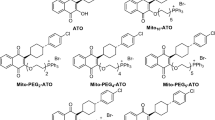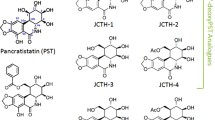Abstract
We report the analysis of CPI-613, the first member of a large set of analogs of lipoic acid (lipoate) we have investigated as potential anticancer agents. CPI-613 strongly disrupts mitochondrial metabolism, with selectivity for tumor cells in culture. This mitochondrial disruption includes activation of the well-characterized, lipoate-responsive regulatory phosphorylation of the E1α pyruvate dehydrogenase (PDH) subunit. This phosphorylation inactivates flux of glycolysis-derived carbon through this enzyme complex and implicates the PDH regulatory kinases (PDKs) as a possible drug target. Supporting this hypothesis, RNAi knockdown of the PDK protein levels substantially attenuates CPI-613 cancer cell killing. In both cell culture and in vivo tumor environments, the observed strong mitochondrial metabolic disruption is expected to significantly compromise cell survival. Consistent with this prediction, CPI-613 disruption of tumor mitochondrial metabolism is followed by efficient commitment to cell death by multiple, apparently redundant pathways, including apoptosis, in all tested cancer cell lines. Further, CPI-613 shows strong antitumor activity in vivo against human non-small cell lung and pancreatic cancers in xenograft models with low side-effect toxicity.







Similar content being viewed by others
References
Hanahan D, Weinberg RA (2011) Hallmarks of cancer: The next generation. Cell 144:646–674
Baggetto LG (1992) Deviant energetic metabolism of glycolytic cancer cells. Biochimie 74:959–974
Christofk HR, Vander Heiden MG, Harris MH, Ramamathan A, Gerszten RE, Wei R, Flemming MD, Schreiber SL, Cantley LD (2008) The M2 splice isoform of pyruvate kinase is important for cancer metabolism and tumour growth. Nature 452:230–234
DeBerardinis RJ, Lum JJ, Hatzivassiliou G, Thompson CB (2008) The biology of cancer: Metabolic reprogramming fuels cell growth and proliferation. Cell Metab 7:11–20
DeBerardinis RJ, Sayed N, Ditsworth D, Thompson CB (2008) Brick by brick: metabolism and tumor cell growth. Curr Opin Genet Dev 18:54–61
Vander Heiden MG, Cantley LC, Thompson CB (2009) Understanding the Warburg effect: The metabolic requirements of cell proliferation. Science 324:1029–1033
Semenza GL (2009) Regulation of cancer cell metabolism by hypoxia-inducible factor 1. Sem Cancer Biol 19:12–16
Cairns RA, Harris IS, Mak TW (2011) Regulation of cancer cell metabolism. Nat Rev Cancer 11:85–95
Garrett R, Grisham CM (2007) Biochemistry. Thomson Brooks, Southbank
Kikuchi G, Motokawa Y, Yoshida T, Hiraga K (2008) Glycine cleavage system: reaction mechanism, physiological significance, and hyperglycinemia. Proceedings of the Japan Academy Series B-Physical and Biological Sciences 84:246–263
Yeaman SJ (1989) The 2-oxo acid dehydrogenase complexes—Recent advances. Biochem J 257:625–632
Roche TE, Baker JC, Yan YH, Hiromasa R, Gong XM, Peng T, Dong JC, Turhan A, Sa K (2001) Distinct regulatory properties of pyruvate dehydrogenase kinase and phosphatase isoforms. Prog Nucl Acid Res and Mol Biol 70:33–75
Bunik VI (2003) 2-oxo acid dehydrogenase complexes in redox regulation: Role of the lipoate residues and thioredoxin. Euro J Biochem 270:1036–1042
Roche TE, Hiromasa Y, Turkan A, Gong X, Peng T, Yan X, Kasten SA, Bao H, Dong J (2003) Essential roles of lipoyl domains in the activated function and control of pyruvate dehydrogenase kinases and phosphatase isoform 1. Euro J Biochem 270:1050–1056
Sugden MC, Holness MJ (2003) Recent advances in mechanisms regulating glucose oxidation at the level of the pyruvate dehydrogenase complex by PDKs. Am J Physiol 284:E855–E862
Roche TE, Hiromasa Y (2007) Pyruvate dehydrogenase kinase regulatory mechanisms and inhibition in treating diabetes, heart ischemia, and cancer. Cell Mol Life Sci 64:830–849
Koukourakis MI, Giatromanolaki A, Giatromanolaki A, Sivridis E, Gatter KC, Harris AL (2005) Pyruvate dehydrogenase and pyruvate dehydrogenase kinase expression in non small cell lung cancer and tumor-associated stroma. Neoplasia 7:1–6
Kim JW, Tchernyshyov I, Semenza GL, Dang CV (2006) HIF-1-mediated expression of pyruvate dehydrogenase kinase: A metabolic switch required for cellular adaptation to hypoxia. Cell Metab 3:177–185
Papandreou I, Cairns RA, Fontana L, Lim AL, Denko NC (2006) HIF-1 mediates adaptation to hypoxia by actively downregulating mitochondrial oxygen consumption. Cell Metab 3:187–197
Denko NC (2008) Hypoxia, HIF1 and glucose metabolism in the solid tumour. Nat Rev Cancer 8:705–713
McFate T, Mohyeldin A, Mohyeldin A, Lu H, Thakar J, Henriquez J, Halim ND, Wu H, Schell MJ, Tsang TM, Teahan O, Zhou S, Califano JA, Jeoun NH, Harris RA, Verma A (2008) Pyruvate dehydrogenase complex activity controls metabolic and malignant phenotype in cancer cells. J Biol Chem 283:22700–22708
Lu CW, Lin SC, Chen KF, Lai YY, Tsai SJ (2008) Induction of pyruvate dehydrogenase kinase-3 by hypoxia-inducible factor-1 promotes metabolic switch and drug resistance. J Biol Chem 283:28106–28114
Schafer ZT, Grassian AR, Song LL, Jiang ZY, Gerhart-Hines Z, Irie HY, Gao SZ, Puigserver P, Brugge JS (2009) Antioxidant and oncogene rescue of metabolic defects caused by loss of matrix attachment. Nature 461:109–114
Takeda Y, Perez-Pinzon MA, Ginsberg MD, Sick TJ (2004) Mitochondria consume energy and compromise cellular membrane potential by reversing ATP synthetase activity during focal ischemia in rats. J Cereb Blood Flow Metab 24:986–992
de Bruin EC, Mederna JP (2008) Apoptosis and non-apoptotic deaths in cancer development and treatment response. Cancer Treat Rev 34:737–749
Nagley P, Higgins GC, Higgins GC, Atkin JD, Beart PM (2010) Multifaceted deaths orchestrated by mitochondria in neurons. Biochim Biophys Acta 1802:167–185
Skulachev VP (2004) Wages of Fear: transient threefold decrease in intracellular ATP level imposes apoptosis. Biochim Biophys Acta 1658:141–147
Cuezva JM, Ortega AD, Willers I, Sanchez-Cenizo L, Aldea M, Sanchez-Arago M (2009) The tumor suppressor function of mitochondria: Translation into the clinics. Biochim Biophys Acta 1792:1145–1158
Tennant DA, Duran RV, Gottlieb E (2010) Targeting metabolic transformation for cancer therapy. Nat Rev Cancer 10:267–277
Bonnet S, Archer SL, Allalunic-Turner J, Harmony A, Beaulieu C, Thompson R, Lee CT, Lopaschuk GD, Puttagunta L, Bonnet S, Harry G, Hashimoto K, Porter CJ, Andrade MA, Thebaud B, Mechelas ED (2007) A mitochondria-K+ channel axis is suppressed in cancer and its normalization promotes apoptosis and inhibits cancer growth. Cancer Cell 11:37–51
Ikediobi ON, Davies H, Bignell G, Edkins S, Stevens C, O'Meara S, Santarius R, Avis T, Barthrope S, Brackenbury L, Buck G, Butler A, Clements J, Cole J, Dicks E, Forbes S, Gray K, Halliday K, Harrison R, Hills K, Hinton J, Hunter C, Jenkinson A, Jones D, Kosmidou V, Lugg R, Menzies A, Mironeneko T, Parker A, Perry J, Raine K, Richardson D, Shepherd R, Small A, Smith R, Soloman H, Stephens P, Teague J, Tofts C, Varain J, Webb T, West S, Widaa S, Yates A, Reinhoid W, Weinstein JN, Stratton MR, Futreal PA, Wooster R (2006) Mutation analysis of 24 known cancer genes in the NCI-60 cell line set. Mol Cancer Ther 5:2606–2612
Rodrigues AR, Rowan A, Smith MEF, Kerr IB, Bodmer WF, Gannon JV, Lane DP (1990) p53 mutations in colorectal cancer. Proc Natl Acad Sci, USA 87:7555–7559
Augenlicht LH, Wadler S, Corner G, Richards C, Multani AS, Pathak S, Benson A, Haller D, Heerdt BG (1997) Low-level c-myc amplification in human colonic carcinoma cell lines and tumors: A frequent p53-independent mutation associated with improved outcome in randomized multi-institutional trial. Cancer Res 57:1769–1775
Acknowledgments
We are grateful to Gregg Semenza and Bob Weinberg for helpful discussions. We thank colleagues, including Pat Hearing, for help early in this project. This work was largely funded by Cornerstone Pharmaceuticals with early support from the Carol M. Baldwin Breast Cancer Research Fund and Stony Brook Biotechnology Center.
Disclosure
Maturo, Gupta, Howell, Schauble, Lem, Piramzadian, Karnik, and Lee are or were employees of Cornerstone Pharmaceuticals, developers of CPI-613. Zachar, Rodriguez, Shorr, and Bingham have a financial interest in Cornerstone Pharmaceuticals.
Author information
Authors and Affiliations
Corresponding author
Electronic supplementary material
Below is the link to the electronic supplementary material.
ESM 1
(PDF 186 kb)
(MOV 1641 kb)
(MOV 2437 kb)
Rights and permissions
About this article
Cite this article
Zachar, Z., Marecek, J., Maturo, C. et al. Non-redox-active lipoate derivates disrupt cancer cell mitochondrial metabolism and are potent anticancer agents in vivo. J Mol Med 89, 1137–1148 (2011). https://doi.org/10.1007/s00109-011-0785-8
Received:
Revised:
Accepted:
Published:
Issue Date:
DOI: https://doi.org/10.1007/s00109-011-0785-8




